Choctaw Nation Behavioral Health staff handed out Naloxone at a harm reduction drive in Durant, Okla. (Photo: Deidre Elrod)
Choctaw Nation Found a Better Way to Deliver Harm Reduction. It's Working.
Through a federal pilot project, the Oklahoma tribe built a new model for addiction care by mixing culture, data, and modern medicine.
Story by Elyse Wild
Photography by Deidre Elrod
This story is the third of a 3-part series produced in partnership with the Pulitzer Center on Crisis Reporting.
DURANT, Okla.— On a scorching 100-degree day in southeastern Oklahoma, Choctaw Nation Behavioral Health workers set up two tables under a small tent in a parking lot at a busy intersection in the town of Durant. White and pink boxes of the anti-overdose drug naloxone sit neatly arranged next to informational handouts about opioid-use disorder.
As cars slow down and pedestrians pass by, occasional visitors approach the table. Each receives a warm welcome and a brief, but potentially life-saving, training. Staff members demonstrate how to properly administer naloxone, with one lying on the chipped asphalt while another shows how to use the nasal spray.
The street-level distribution became crucial after naloxone (often sold under the brand name Narcan) became available over the counter in 2023. Pharmacies now stock it, but the $45 price tag for two doses is out of reach for many, especially in rural areas. The distribution drives are part of the Choctaw Nation’s systematic approach to preventing overdose deaths on its 10,800-square-mile reservation.
While national overdose rates declined from 2022-2023, Native communities continue to see increases. The challenges are particularly acute for tribal nations, which are typically located in rural areas where health access is limited by distance, poverty, and lack of infrastructure. These barriers, combined with generational trauma, broken treaty promises, and chronic underfunding, have created ideal conditions for the opioid crisis.
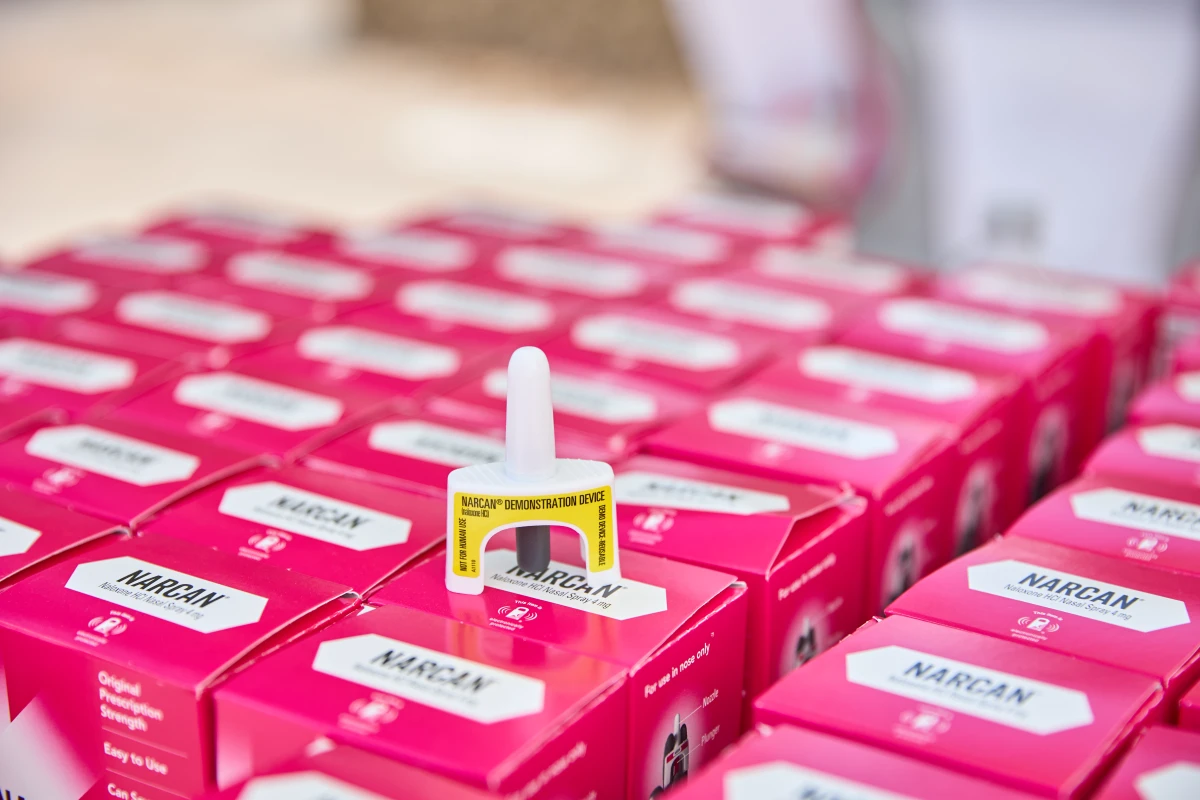
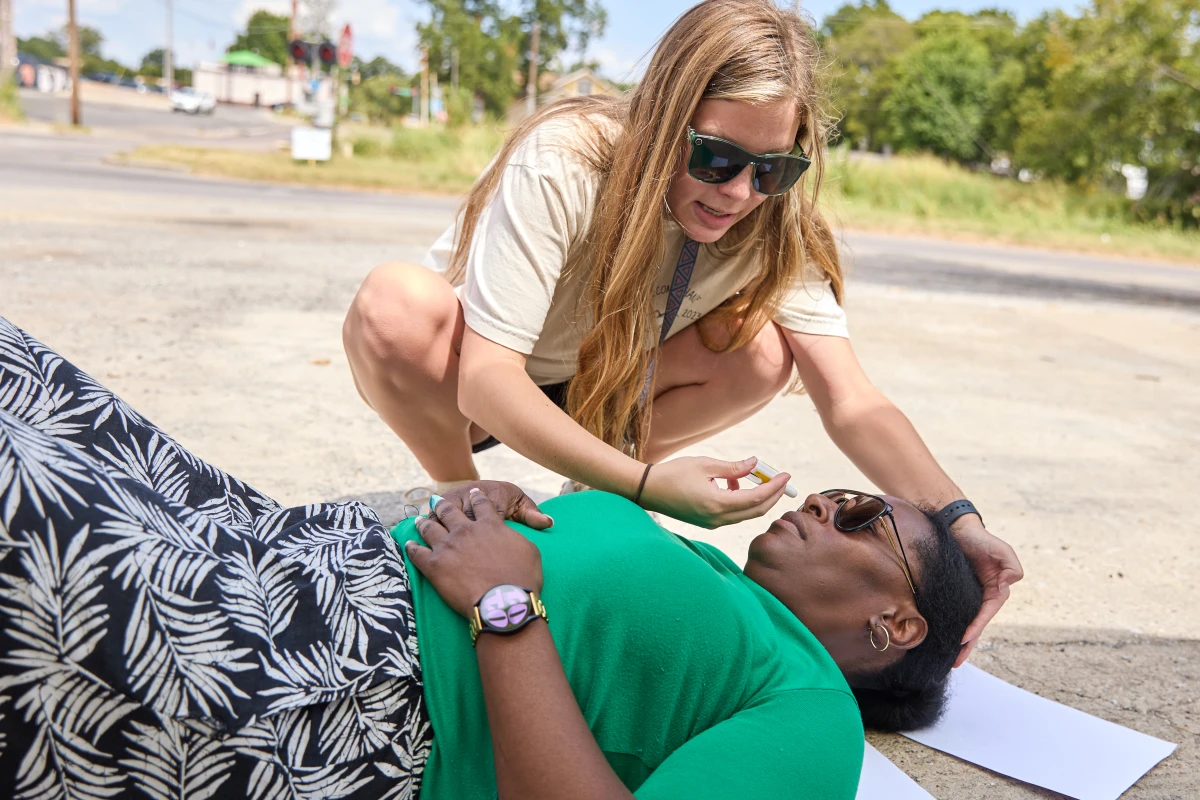
A Choctaw Nation Behavioral Health staffer demonstrates how to administer naloxone to a person overdosing from opioids. The drug binds to opioid receptors in the brain to reverse the effects of an overdose.
The FDA approved naloxone in 2015 to reverse opioid overdoses. It’s available primarily as a nasal spray, and anyone with basic training can administer it. As Native communities battle against the deadly surge of fentanyl, naloxone has become their most powerful tool for saving lives.
The naloxone distribution program on Choctaw Nation reflects a broader public health strategy called harm reduction, an approach to drug use aimed at reducing its worst effects — like death and disease — without demanding abstinence from drug users. It emerged in the 1980s in the U.S., with local communities, driven largely by grassroots movements, opening centers where heroin users could exchange used needles for clean ones to reduce the spread of AIDS.
While research shows harm reduction saves lives and experts consider it crucial to addiction care, these programs often face resistance. There is still stigma related to addiction among many tribal citizens. And some fear programs providing naloxone and clean needles will enable drug use, though multiple studies have found no evidence supporting this concern.
A Coordinated Response
In 2019, as overdose deaths rose sharply in Native communities, the Indian Health Service launched the Community Opioid Intervention Pilot Project (COIPP), awarding $16 million in grants to tribes developing culturally informed responses to the crisis. The Choctaw Nation saw an opportunity to transform how it delivers addiction services on the Oklahoma reservation.
Through their COIPP grant, the tribe hired a dedicated team – a project director, cultural treatment advocate, and prevention specialist – to build a coordinated response spanning from street-level prevention to long-term recovery support. The program combines the distribution of naloxone and other substance-abuse deterrent measures, expanded access to medication-assisted treatment, and culturally specific treatment curricula for the Nation's residential centers.
Samantha McGee, grant project director at the Choctaw Nation Health Service Authority, has overseen naloxone distribution to the tribe’s first responders since 2018. In the program’s early days, she loaded her car with naloxone kits and drove through Choctaw Nation’s ten counties to train staff at fire departments, emergency medical-service centers, and police stations. Since then, the program has evolved into a more comprehensive approach, distributing more than 5,400 naloxone kits — funded partially by the COIPP grant.
On the ground, attitudes have shifted and the stigma against harm reduction has shifted, McGee said. First responders began reporting that community members were approaching them to ask for naloxone they could carry themselves. That reflects a national trend. According to an evaluation of national data published by the Journal of the American Medical Association in October, the number of cases where people other than medical personnel administered naloxone before EMS arrived increased by 43.5% from 2020 to 2022, to about 25,000 people.
“The proof is in the pudding,” McGee said. “I don’t really need to convince anyone anymore. Before, they may not have experienced it in their job. But now, they deal with it every day, and they are grateful.”
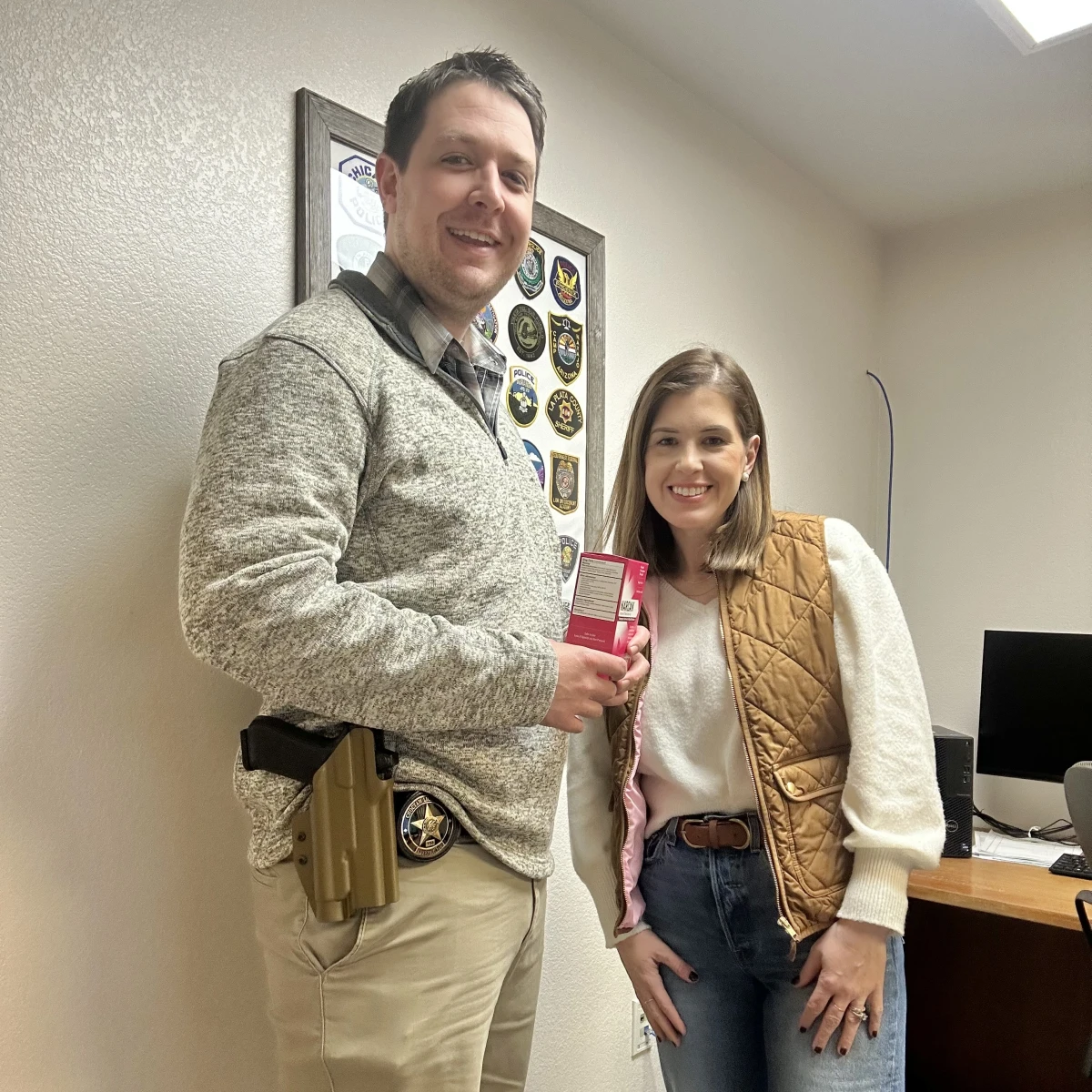
Samantha McGee of the Choctaw Nation Health Services Authority is pictured here with Choctaw Nation Lighthorse officer Dalton Loggains. McGee oversees the tribe's naloxone distribution to Choctaw Nation’s first responders. (Courtesy photo.)
Using Data to Save Lives
The Choctaw Nation drives were first launched in 2020, born from community feedback. Lacey Callahan, grants operation manager for the behavioral health center, explains that their original approach — hour-long formal presentations — wasn’t working.
“What we heard from our community is that (the presentations) did not feel safe,” Callahan said. “What felt safer to them was to discreetly come through on their terms, when it was convenient for them, receive a smaller training just on how to use it, and not have law enforcement present.”
The tribe now strategically places these drives based on precise data analysis. Mason Emert, an epidemiologist with the Choctaw public-health department, studies statewide overdose information collected in a federally developed program called the Overdose Detection Mapping Application Program (ODMAP), where users enter overdose data into a cross-jurisdictional database.
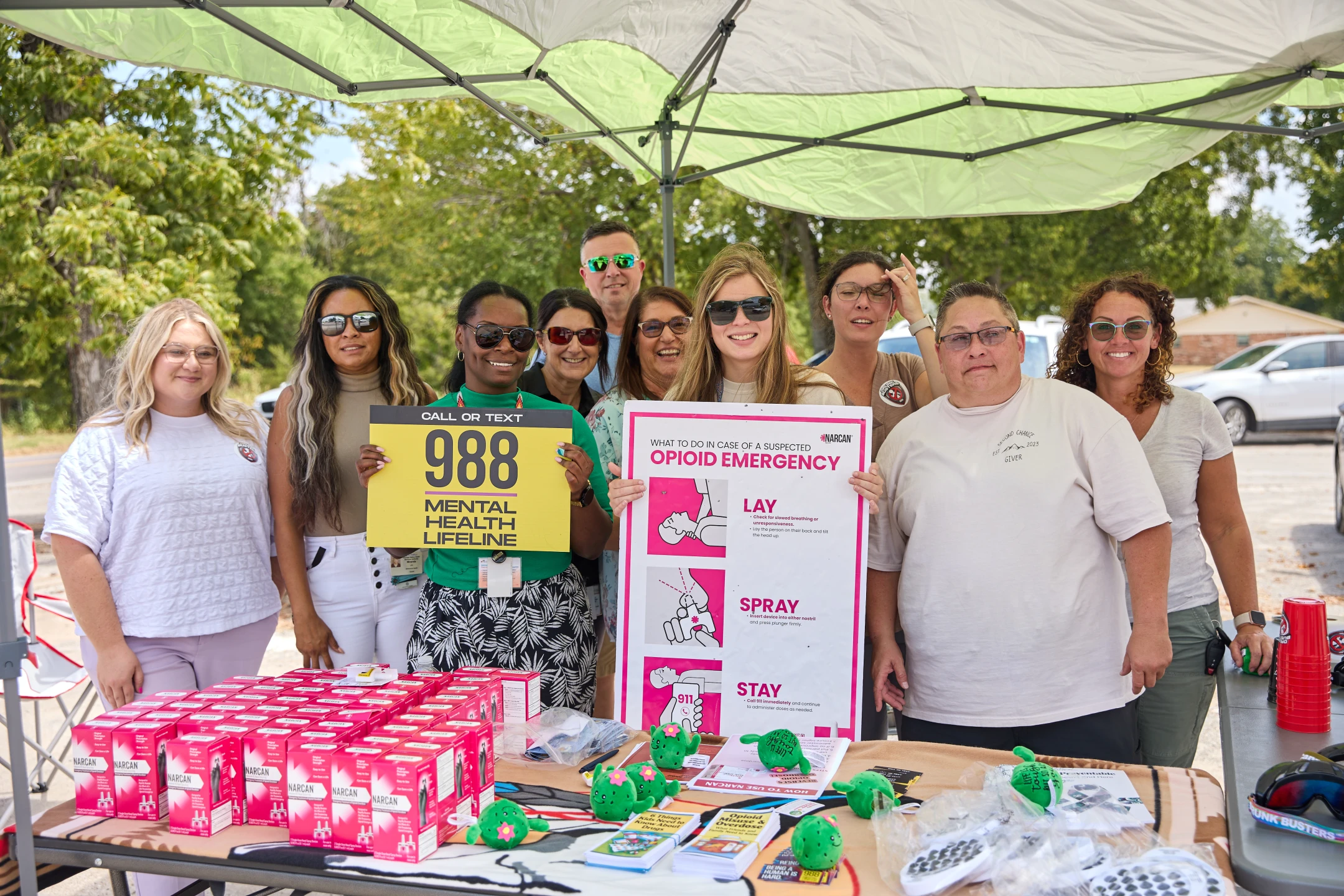
The Choctaw Nation Behavioral Health team displays naloxone kits and educational materials at a distribution drive. The tribe uses data from the Overdose Detection Mapping Application Program (ODMAP) to strategically place these drives where they're most needed.
Using heat mapping, Emert can see which communities within the Choctaw Nation counties are experiencing more overdoses, right down to specific dates, to inform the tribe's Behavioral Health Department about where harm-reduction supplies may be needed most.
“It really serves us well to have that direct line of communication with each other,” Emert said.
Problematic data — whether incomplete, inconsistent, or one-dimensional — is often cited as the bane of getting information about both the overdose crisis and health disparities in Native communities. While ODMAP data show overdoses in which first responders have been called, there's no way to track unreported incidents, such as nonfatal overdoses where neither health-care personnel nor law enforcement are present.
ODMAP debuted a new function this year that lets users report naloxone distribution. But, Emert said, it hasn't been utilized consistently enough to show any data for the Choctaw Nation service area.
Still, he sees the system as a good start. “We are exploring different avenues on the public health side,” he said. “On the horizon, we're just working to improve the full data picture, but also work collaboratively with those other entities that are collecting data as well, so that we can all have the complete image.”
The Treatment Program
In Talihina, a quiet town about 100 miles northeast of Durant, pharmacist and Choctaw Nation citizen Clark Austin oversees another key component of the tribe’s harm-reduction strategy: medication-assisted treatment (MAT). The clinic, which opened in 2023, dispenses two key medications to treat opioid addiction: Suboxone, which satisfies cravings without providing a sense of euphoria, and Naltrexone, which blocks opioid receptors entirely.
Austin said signs of the overdose crisis were apparent in Choctaw Nation’s healthcare system, indicating it was time for a clinic dedicated to long-term recovery. "We had many patients come through our emergency services and patients on the hospital floor who were coming in for detox services," Austin said. "We saw that this needed to exist."
The program takes an individualized approach, with treatment plans tailored to each patient’s recovery goals. Some choose to taper off medication entirely, while others maintain long-term treatment. Already, the clinic has treated two dozen patients — four times their initial goal.
"We've had several patients that have tapered completely off of the medication and done really, really well," Austin said. "We've had patients that have tapered off and had to come back to the clinic to reinitiate the medication. We allow the patients to kind of self-lead their treatment plans, but we do always and consistently re-evaluate their goals."
The clinic looks at several factors to determine if the program is on the right track, especially the parts of people's lives where addiction typically wages the most destruction — relationships and employment.
While medication helps manage the physical aspects of addiction, the tribe recognized that lasting recovery requires a different level of healing. That understanding led the tribe to another approach.
Healing through culture
When community members were initially hesitant, the tribe began reframing the messaging around harm reduction within traditional Choctaw Nation values.
“We had to change our messaging and really heighten our presence, talking about it as a way to save a life,” Callahan said. “If we can save a life and spare someone from the heartache, that could potentially give them a second chance to make a huge impact.”
This cultural approach extends beyond messaging. At Chi Hullo Li, a long-term women's residential treatment program in Talihina, the tribe is putting these values into practice with a culturally centered recovery curriculum. The 18-bed facility, certified through the American Society of Addiction Medicine, serves Native American women from any federally recognized tribe — and if necessary, their children — during three- to six-month stays.
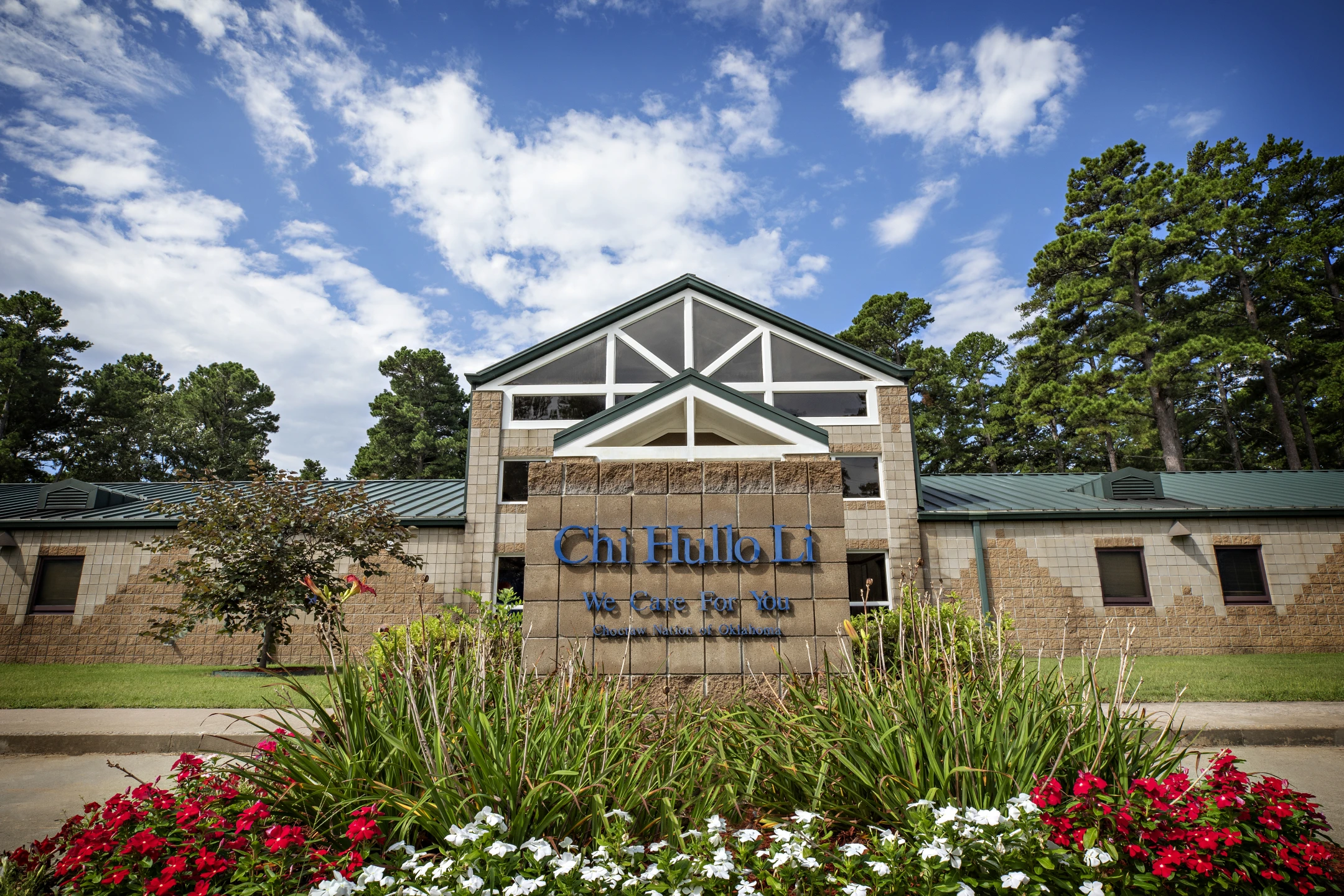
At Chi Hullo Li, a long-term women’s residential treatment center in Talihina, Okla., Native women follow a recovery curriculum centering Choctaw traditions and beliefs. (Courtesy photo)
This summer, the center introduced “We Shall Remain: Chahta-Inspired Wellbeing and 12-Step Journey,” a recovery curriculum designed by Cultural Treatment Advocate Callie Hagelberger, a Choctaw citizen. It was inspired by the White Bison and the Wellbriety Movement, widely lauded addiction-treatment programs geared toward Native Americans and created by Don Coyhis, a member of the Mohican Nation from the Stockbridge Munsee Reservation in Wisconsin.
"We Shall Remain" is used in both recovery centers and jails in the area. When creating the curriculum, Hagelberger dove deeply into the archives at the Choctaw Nation Cultural Center and consulted tribal elders, incorporating elements like the Chahta Medicine Wheel — tobacco, sweet grass, sage, and cedar — along with traditional land-management techniques, stories, prayers, and meditations.
“The best thing I have heard a client say about the lessons in We Shall Remain is ‘I didn't know any of this was part of my culture, part of who I am,’” Hagelberger said.
A Path to Recovery
The power of cultural connection isn’t just a theory. For those who have experienced addiction, knowing they belong to a community that cares can be the difference between despair and hope.
Clayton Clark, a citizen of the Choctaw Nation, carries four doses of naloxone at all times. “With fentanyl and opioids so readily available — it's just everywhere now,” he said. “You really never know.”
Clark, 38, knows just how important another chance at life can be. His addiction began with pain management for a back injury, and escalated to spending $800 a week, taking some 200 pills to stave off withdrawals. His relationship with his grandfather, who raised him, nearly shattered; the mother of his children evicted him from their home; and he eventually spent months living in a homeless shelter while waiting for a spot in rehab.
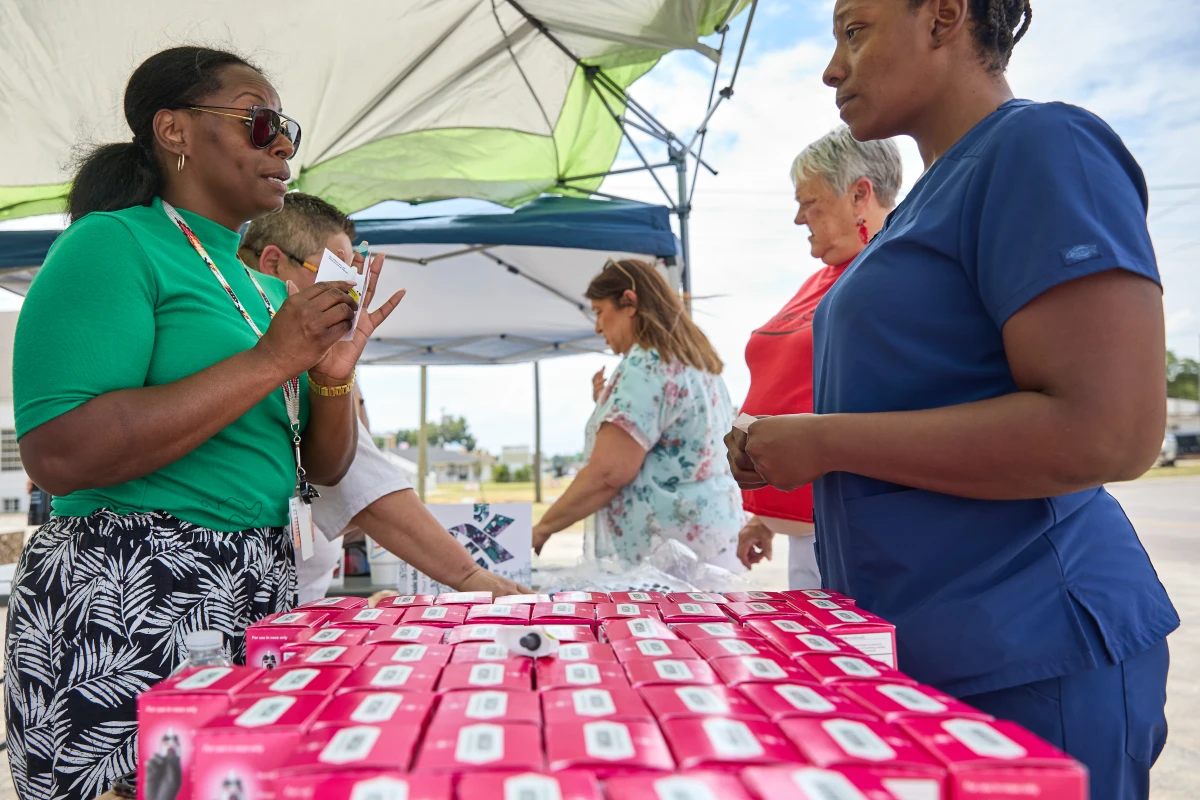
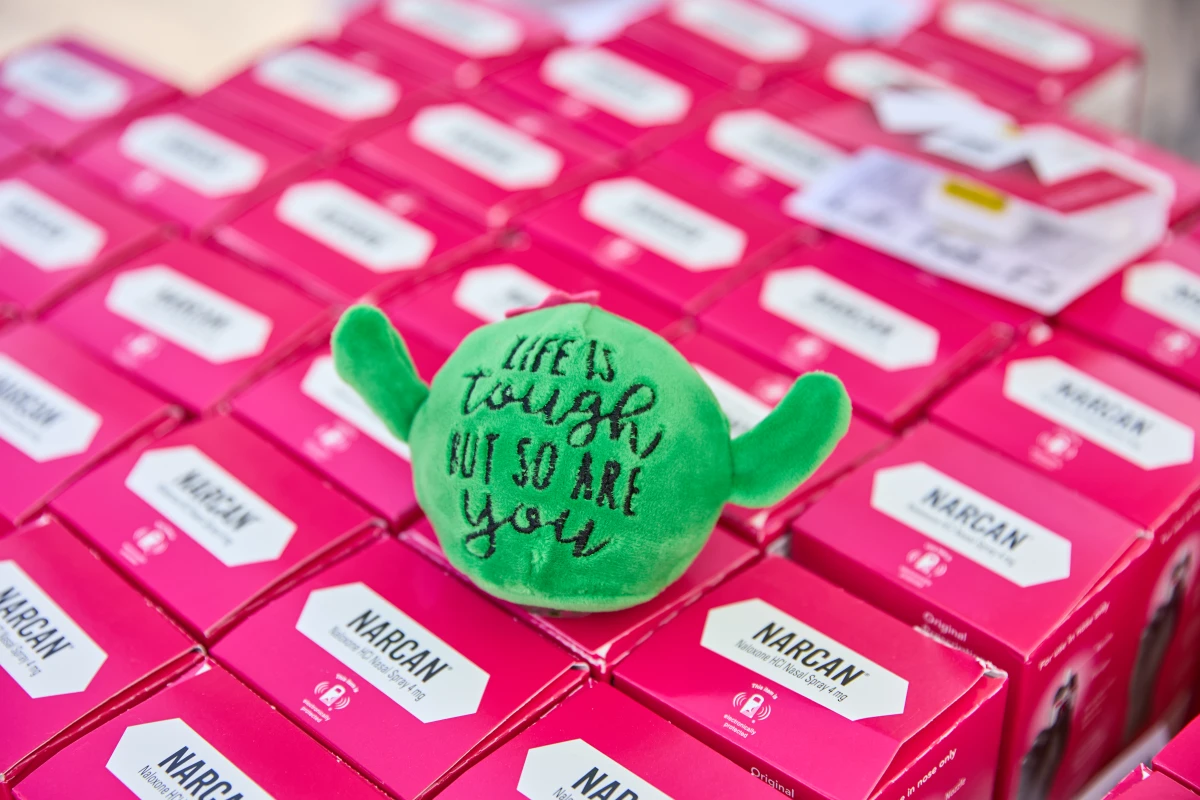
At a harm-reduction drive in Durant, Okla., Choctaw Nation Behavioral Health’s Latoya James describes how naloxone works.
Today, Clark is five years into recovery and works as a peer-support specialist for Lighthouse Behavioral Health, a partner of Choctaw Nation.
“The most challenging part of addiction was, the further I got into it, the feeling of not being able to get out of it, like it was hopeless, like there towards the end, it felt like I was stuck, like, this is who I am,” he said. “The thing I love most about being Choctaw, no matter how lonely I get, or how bad my depression gets, I know that I have a huge support with my family and friends and my tribe.”
For Clark and Choctaw Nation, making naloxone widely available aligns with traditional tribal values. Through the COIPP pilot project, the tribe has created a model that addresses multiple challenges: bringing life-saving supplies directly to the community and its citizens; using data to distribute resources where they’re needed most; and grounding treatment in cultural practices that help Native people reconnect with their identity.
The approach is showing results across every level: More than 5,400 naloxone kits have been distributed throughout the community. The MAT clinic is serving four times more patients than projected. Choctaw citizens in the culturally based treatment program are reconnecting with traditional healing practices. The tribe has built a comprehensive system that meets Choctaw citizens where they are — whether that’s on a street corner, in a clinic, or in a healing circle.
“It's just them showing people, no matter whether you're doing really well or at rock bottom, it doesn't matter,” Clark said. “I believe it shows that no matter what you are within our community, within our Native community, we still care. No matter what.”
